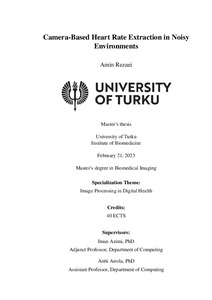Camera-Based Heart Rate Extraction in Noisy Environments
Rezaei, Amin (2023-03-02)
Camera-Based Heart Rate Extraction in Noisy Environments
Rezaei, Amin
(02.03.2023)
Julkaisu on tekijänoikeussäännösten alainen. Teosta voi lukea ja tulostaa henkilökohtaista käyttöä varten. Käyttö kaupallisiin tarkoituksiin on kielletty.
avoin
Julkaisun pysyvä osoite on:
https://urn.fi/URN:NBN:fi-fe2023042037924
https://urn.fi/URN:NBN:fi-fe2023042037924
Tiivistelmä
Remote photoplethysmography (rPPG) is a non-invasive technique that benefits from video to measure vital signs such as the heart rate (HR). In rPPG estimation, noise can introduce artifacts that distort rPPG signal and jeopardize accurate HR measurement. Considering that most rPPG studies occurred in lab-controlled environments, the issue of noise in realistic conditions remains open.
This thesis aims to examine the challenges of noise in rPPG estimation in realistic scenarios, specifically investigating the effect of noise arising from illumination variation and motion artifacts on the predicted rPPG HR. To mitigate the impact of noise, a modular rPPG measurement framework, comprising data preprocessing, region of interest, signal extraction, preparation, processing, and HR extraction is developed. The proposed pipeline is tested on the LGI-PPGI-Face-Video-Database public dataset, hosting four different candidates and real-life scenarios. In the RoI module, raw rPPG signals were extracted from the dataset using three machine learning-based face detectors, namely Haarcascade, Dlib, and MediaPipe, in parallel. Subsequently, the collected signals underwent preprocessing, independent component analysis, denoising, and frequency domain conversion for peak detection.
Overall, the Dlib face detector leads to the most successful HR for the majority of scenarios. In 50% of all scenarios and candidates, the average predicted HR for Dlib is either in line or very close to the average reference HR. The extracted HRs from the Haarcascade and MediaPipe architectures make up 31.25% and 18.75% of plausible results, respectively. The analysis highlighted the importance of fixated facial landmarks in collecting quality raw data and reducing noise.
This thesis aims to examine the challenges of noise in rPPG estimation in realistic scenarios, specifically investigating the effect of noise arising from illumination variation and motion artifacts on the predicted rPPG HR. To mitigate the impact of noise, a modular rPPG measurement framework, comprising data preprocessing, region of interest, signal extraction, preparation, processing, and HR extraction is developed. The proposed pipeline is tested on the LGI-PPGI-Face-Video-Database public dataset, hosting four different candidates and real-life scenarios. In the RoI module, raw rPPG signals were extracted from the dataset using three machine learning-based face detectors, namely Haarcascade, Dlib, and MediaPipe, in parallel. Subsequently, the collected signals underwent preprocessing, independent component analysis, denoising, and frequency domain conversion for peak detection.
Overall, the Dlib face detector leads to the most successful HR for the majority of scenarios. In 50% of all scenarios and candidates, the average predicted HR for Dlib is either in line or very close to the average reference HR. The extracted HRs from the Haarcascade and MediaPipe architectures make up 31.25% and 18.75% of plausible results, respectively. The analysis highlighted the importance of fixated facial landmarks in collecting quality raw data and reducing noise.
